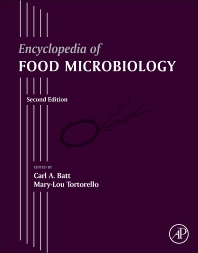Books in Agricultural and biological sciences
Books in Agricultural and biological sciences
The Agricultural and Biological Sciences collection advances science-based knowledge for the improvement of animal and plant life and for secure food systems that produce nutritious, novel, sustainable foods with minimal environmental impact. Food Science titles include not only those products from agriculture but all other aspects from food production to nutrition, health and safety, chemistry to security, policy, law and regulation. Biological Sciences address animal behaviour and biodiversity, organismal and evolutionary biology, entomology, marine biology and aquaculture, plant science and forestry.
- 3rd Edition
- April 9, 2014
- Wojciech J. Florkowski + 3 more
- English
- Paperback9 7 8 0 1 2 8 1 0 0 9 9 8
- Hardback9 7 8 0 1 2 4 0 8 1 3 7 6
- eBook9 7 8 0 1 2 4 1 0 4 3 5 8

Postharvest Handling
- 1st Edition
- April 8, 2014
- Z Jin
- English
- Paperback9 7 8 0 8 5 7 0 9 6 6 1 6
- Paperback9 7 8 0 0 8 1 0 1 4 0 7 3
- eBook9 7 8 0 8 5 7 0 9 6 7 3 9

Computational Modelling of Biomechanics and Biotribology in the Musculoskeletal System
- 1st Edition
- April 5, 2014
- Victor R Preedy
- English
- Paperback9 7 8 0 1 2 8 1 0 2 8 5 5
- Hardback9 7 8 0 1 2 4 0 4 7 3 8 9
- eBook9 7 8 0 1 2 4 0 4 6 9 5 5

Processing and Impact on Antioxidants in Beverages
- 1st Edition
- April 3, 2014
- N.M. Nayar
- English
- Paperback9 7 8 0 1 2 8 1 0 2 6 8 8
- Hardback9 7 8 0 1 2 4 1 7 1 7 7 0
- eBook9 7 8 0 1 2 4 1 7 1 8 9 3

Origins and Phylogeny of Rices
- 1st Edition
- April 3, 2014
- Michele Jeanne Sadler
- English
- Hardback9 7 8 0 8 5 7 0 9 8 4 2 9
- Paperback9 7 8 0 0 8 1 0 1 4 0 5 9
- eBook9 7 8 0 8 5 7 0 9 8 4 8 1

Foods, Nutrients and Food Ingredients with Authorised EU Health Claims
- 2nd Edition
- April 2, 2014
- Richard K. Robinson + 1 more
- English
- Hardback9 7 8 0 1 2 3 8 4 7 3 0 0
- eBook9 7 8 0 1 2 3 8 4 7 3 3 1

Encyclopedia of Food Microbiology
- 1st Edition
- April 1, 2014
- Victor R Preedy
- English
- Paperback9 7 8 0 1 2 8 1 0 0 8 1 3
- Hardback9 7 8 0 1 2 4 0 1 7 1 7 7
- eBook9 7 8 0 1 2 4 0 4 6 0 6 1

Handbook of Nutrition, Diet, and the Eye
- 1st Edition
- March 28, 2014
- Anika Niambi Al-Shura
- English
- Paperback9 7 8 0 1 2 8 0 0 1 2 0 2
- eBook9 7 8 0 1 2 8 0 0 6 3 8 2

Physical Examination in Cardiovascular Chinese Medicine
- 1st Edition
- March 24, 2014
- Mike Boland + 2 more
- English
- Paperback9 7 8 0 1 2 8 1 0 1 0 7 0
- Hardback9 7 8 0 1 2 4 0 4 6 1 0 8
- eBook9 7 8 0 1 2 4 0 4 6 8 5 6

Food Structures, Digestion and Health
- 1st Edition
- March 21, 2014
- Tatiana Koutchma
- English
- Paperback9 7 8 0 1 2 4 1 6 6 2 1 9
- eBook9 7 8 0 1 2 4 1 6 6 6 8 4

Preservation and Shelf Life Extension